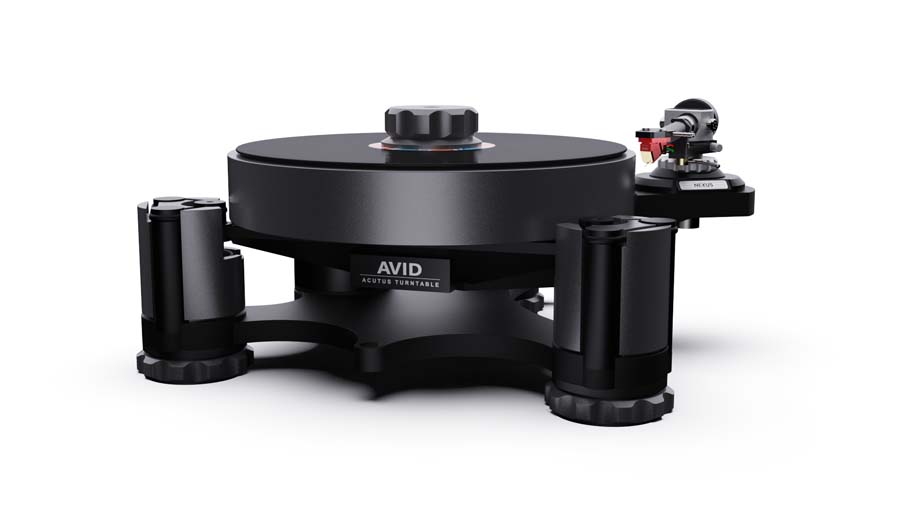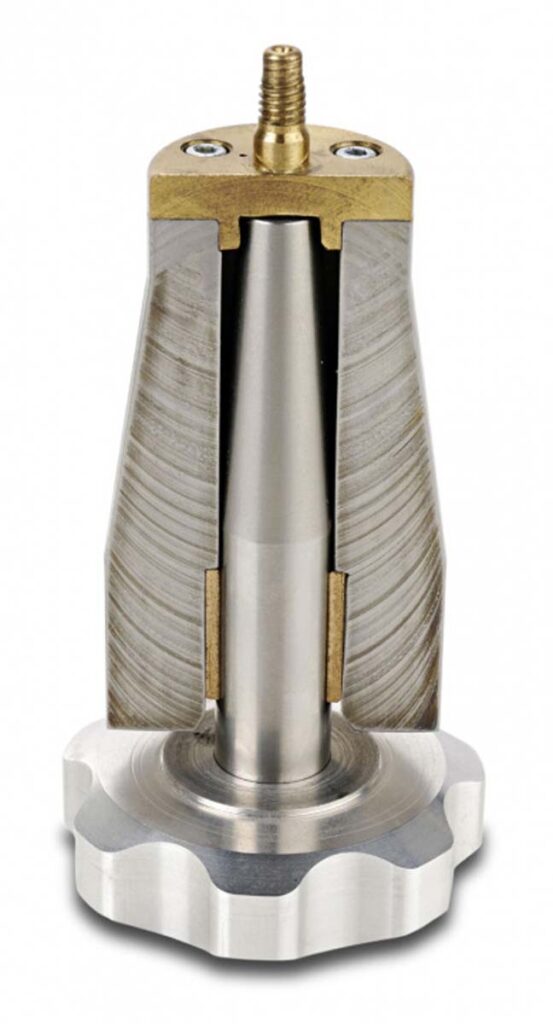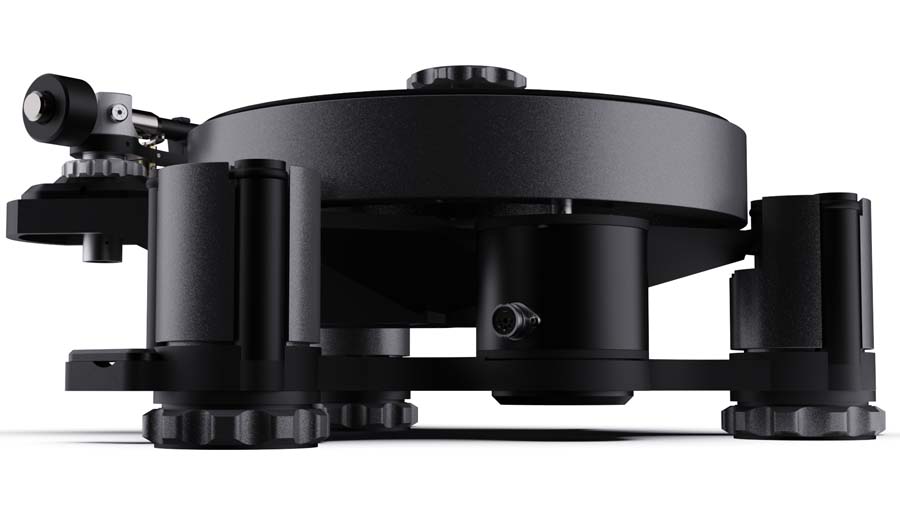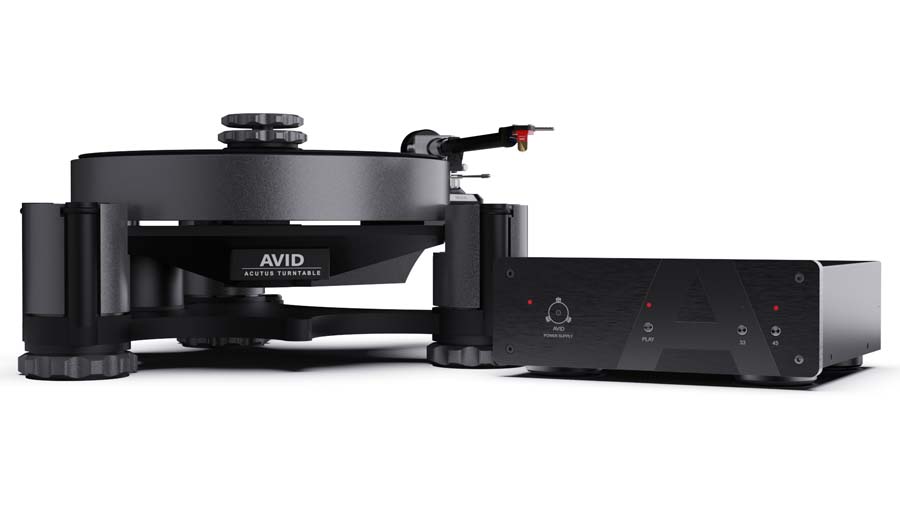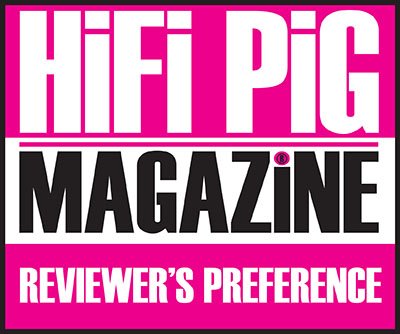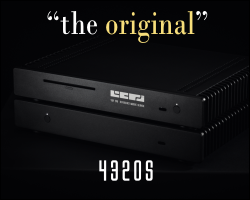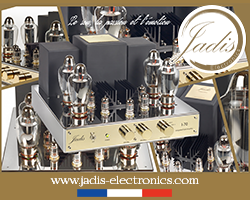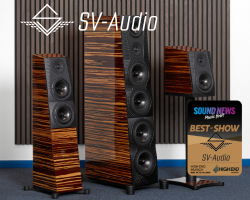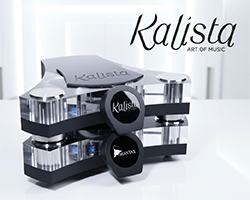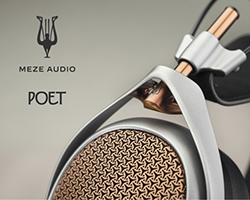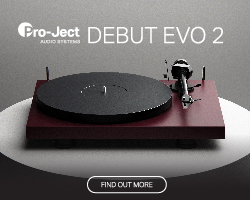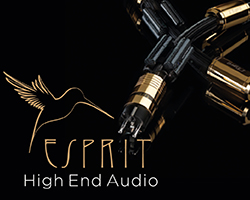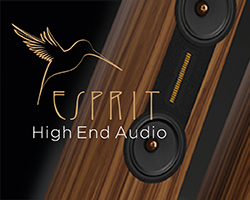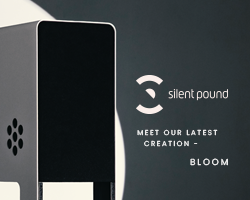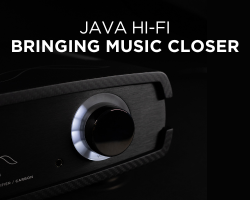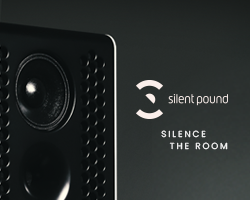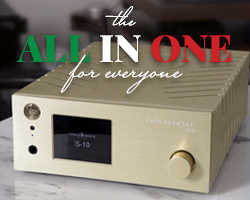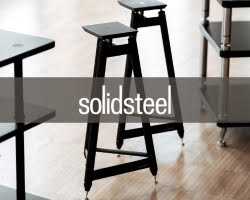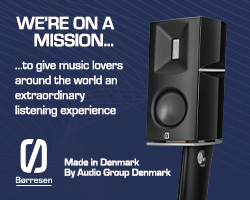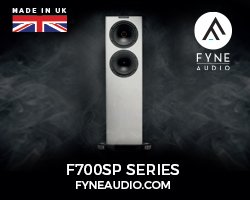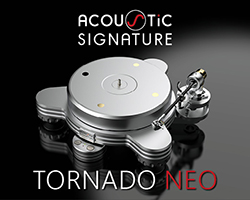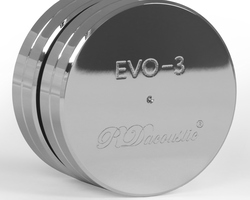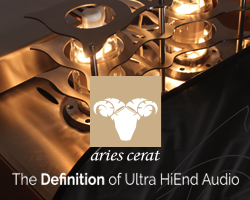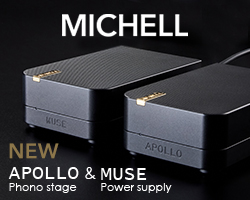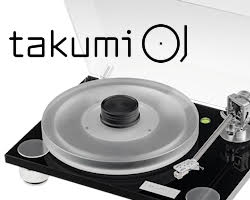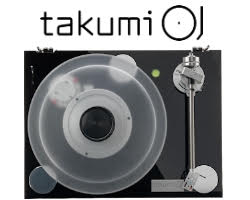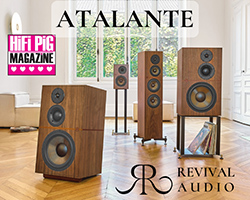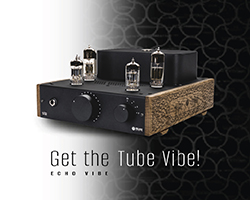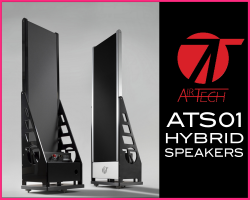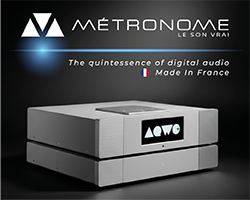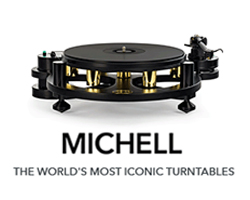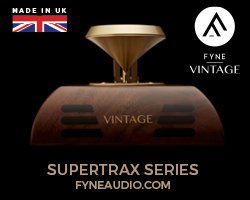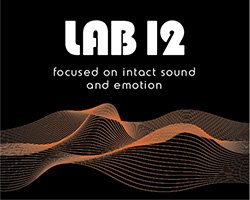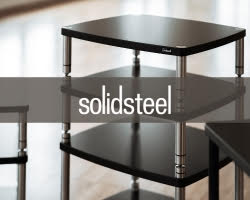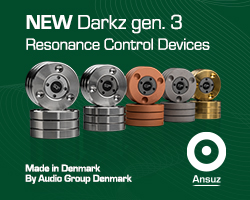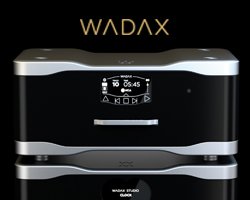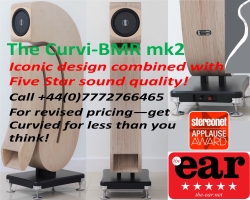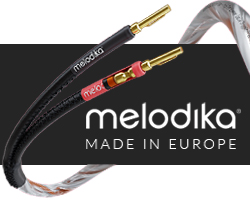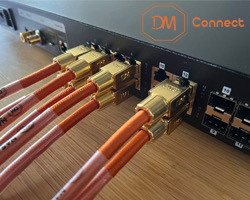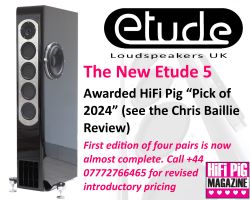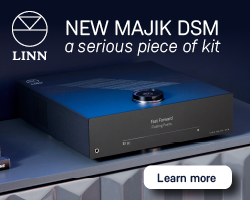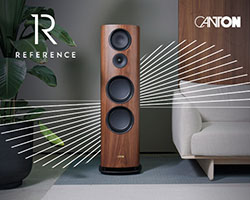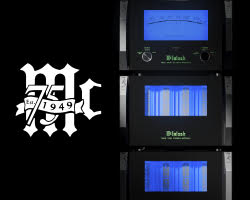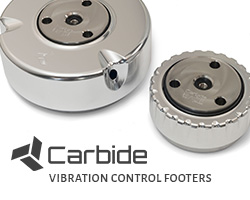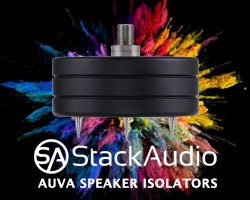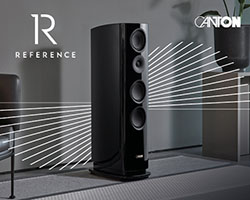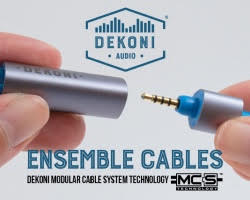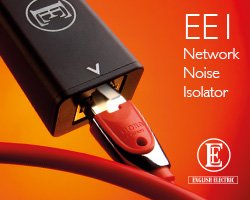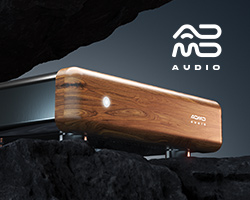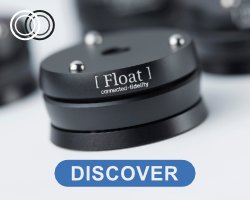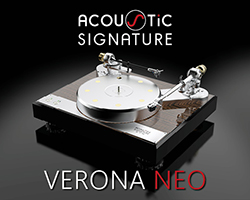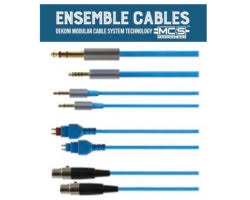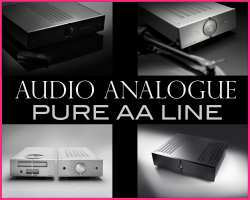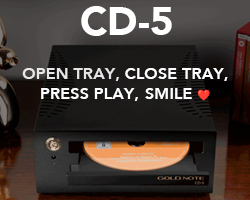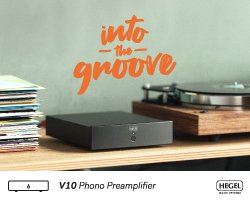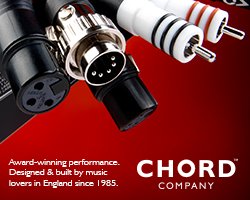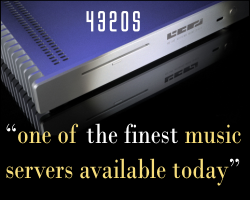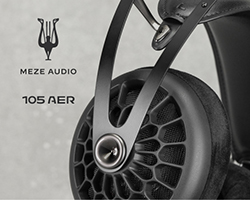AVID HIFI ACUTUS DARK IRON TURNTABLE REVIEW
AVID HIFI Acutus Dark Iron turntable is a tour-de-force of real engineering, put to producing a turntable that sits in the English brand’s top tier of turntables. In this review of the Acutus Dark Iron, Janine Elliot takes a close listen and discusses the engineering involved in this impressive vinyl spinner.

I was talking with a friend a few days ago who was busily telling me that Ai was writing his essays, and his wife was using Ai to advise her on what shares to buy. Yes, Ai seems to be a growing part of people’s lives, but could it ever replicate the knowledge in the mind of CEO Conrad Mas from AVID HIFI, based in Kimbolton, near Huntingdon, Cambridgeshire? I don’t think so! The amount of engineering in the Dark Iron turntable, plus the Nexus arm, and Boron cartridge that arrived in a box for me to review, would take hours and several chapters of explaining if I went into the full detail. Such is the mind of Conrad: everything he produces — at both of his factories — is cleverly engineered down to the minutest detail. His company, formed in 1995, really began much earlier in 1977 when 16-year-old Conrad constructed his own turntable at home, having not been satisfied with his Connoisseur BD1 plus Acos Lustre arm – at the time an archetypal duo for the bourgeoning audiophile. He spent hours trying to improve it, which eventually led to him creating his first Acutus T turntable in 1995. What he realised was that the real enemy of the turntable wasn’t just the rumble or wow and flutter, but predominantly the suspension. Conrad was lucky enough to test his theories with local universities, and at one point, he even worked in a foundry to learn about the casting of metals. His varied career included insurance and glazing, Musical Fidelity and Acoustic Arts, the latter operated from a building I passed every time I went for piano and violin lessons at the Watford School of Music. Since his very first turntable, AVID HIFI has morphed into creating everything from source to end-point, encompassing cartridge, arm, turntable, cabling, phono-stage, amplification, speakers, and even the stands and equipment racks. All created and constructed at the AVID factories.
When introduced to the possibility of reviewing the Dark Iron, my imagination swept into visions of a Trojan Horse or a man dressed in armour, racing abreast a giant horse in a muddy field at the Battle of Hastings. I wasn’t far out; this turntable is built to survive, is heavy, looks menacing, designed to soldier on forever, but only has three legs and one arm. Coming in at £10,000 in basic form for the turntable, you can add an upgraded resin mat for £2,500, upgrade the clamp for £500, and then of course you need to add the arm and cartridge. For this review sample, Conrad supplied me with the upgraded mat, plus Nexus arm at £4,950 and the Boron cartridge at another £4,500. Total outlay £21,950. A lot more than their entry model all-in-one Ingenium at £1,500, but still significantly less than their top-of-the-range Acutus Reference Mono at £37,500 excluding arm/cartridge. But don’t think these numbers are meaningless, given the engineering, materials, and brain power required. This model is similar to the more expensive shiny chrome Classic turntable (at £17,000), though it comes in a more fetching black and metallic grey finish.
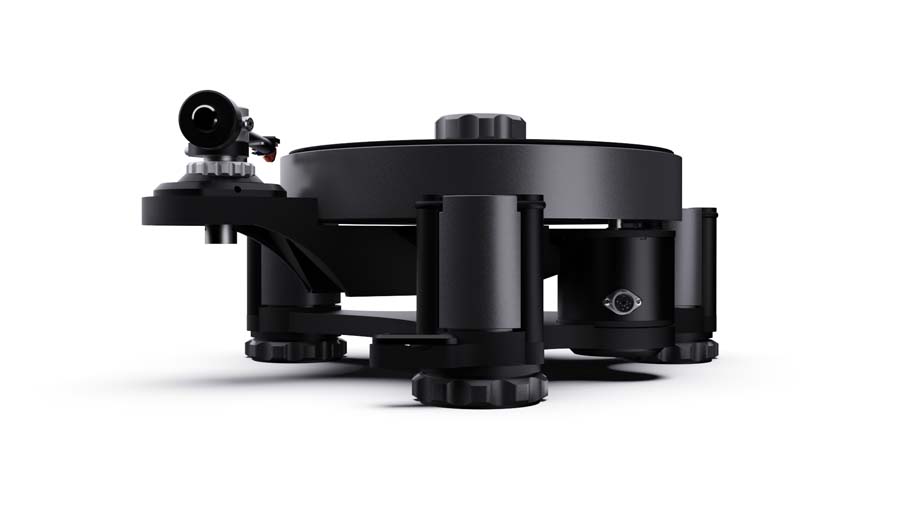
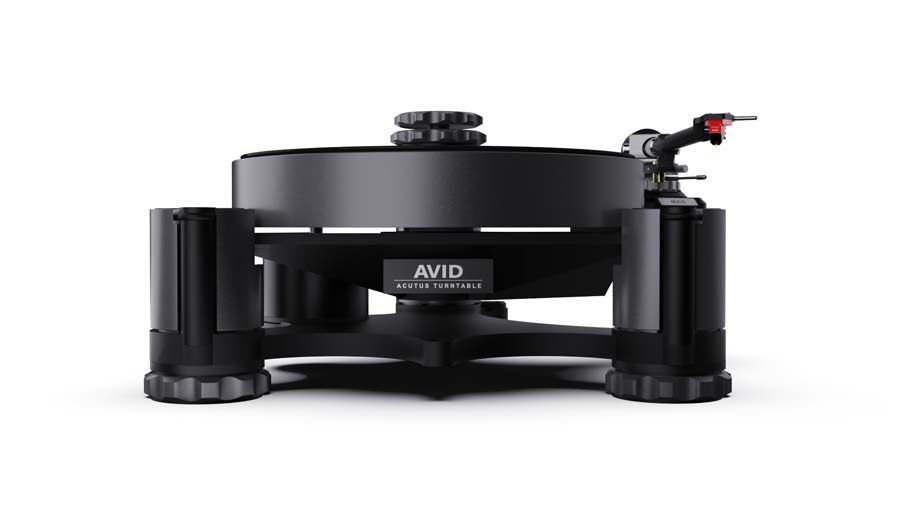
BUILD QUALITY
There are three specific areas which are vital in the design of the Dark Iron, or, indeed, any other Acutus for that matter: suspension, bearing and clamping. This turntable is basically a cast aluminium base unit with the motor an integral part of the design to ensure constant belt alignment, a sprung-mounted sub chassis with elastomer band supports to stop lateral rotation and dampen vertical movement, and a heavy aluminium platter fed by two belts from the motor. Of course, it is far more detailed than this…
The Constituent Parts
The Base Unit is a heavy, machined aluminium body with the ubiquitous three feet to keep it level. There is even a spirit level at the front middle so you can check your house isn’t parked on a hill, and each foot is adjustable (more on that in a moment). The Dark Iron follows Conrad’s philosophy of suspended Sub-chassis, which fits into the top of those three legs and is motioned by large springs inside each one. Added to that are the three elastomer bands to prevent a twisting rotational horizontal movement. The arm, just as in any sensible suspended turntable, is connected to that sub-chassis, which in a moment of “hey, watch this!” permitted me later to play a record and allow the sub-chassis to bounce up and down without the stylus jumping and skipping grooves. Clever, though don’t try this at home, as they say on the telly. The suspension is even more clever than this. When you fit your arm to any turntable, the weight distribution around the turntable will obviously alter, and this also means that the vibrational frequency of each foot will now be different. The beauty of the Dark Iron, as in most AVIDs, is that you can alter that frequency so that they are all the same; ideally 2.5Hz which is lower than the lowest audible frequency of the cartridge, and thence cannot be picked up or affect other frequencies (i.e; the first harmonic would be 5Hz which is still too low). The arm/cartridge compliant frequency is usually around 10Hz, so anything below that will keep it rigid. Therefore, the cartridge is rigidly connected to the record even whilst the suspension is moving. Try opening a seismograph app on your phone and place it onto the platter and jump up and down in your room. There really shouldn’t be any reading, though you might look a bit silly. The sub-chassis is also extremely strong with its triangular bracing, with maximum rigidity deliberately where the arm is connected to the spindle.
The Main Bearing is the next vital part of the conundrum. I remember my first noisy idler-driven turntable as a small child. Yes, they can be noisy, but it was the bearing on which the platter sat that was the real culprit. My Garrard 301 was idler driven, but not as noisy as my earlier turntables because it not only had a good bearing this time, but I had built a massive, heavy plinth that worked like an earth and sent the noise to ground rather than up to my cartridge. Similarly, the Dark Iron has a cleverly designed spindle which is a tapered cone geometry, so that the base has a larger diameter than at the top, meaning that vibrations will head from the clamped record to the wider base and then to the sub-chassis, like a mechanical diode. Not only this, but due to the non-parallel shape, there will also be no standing waves. The main bearing is hollow and fits over the central spindle on the sub-chassis, and as this is also a tapered conical shape, the platter will sit tightly on top, as this, too, has a tapered hole. Unlike other turntables, it won’t “move about” due to any gap. On top of the central spindle is placed a tungsten carbide ball, which will meet with a sapphire bearing at the top inside of the main bearing. These two elements are self-lubricating, so no oil is needed, as oil lubrication actually creates noise! A mix of a stronger diamond bearing and tungsten carbide ball is, however, not self-lubricating. The main bearing has a low centre of gravity, meaning that it is supported at the base, which means any mechanical noise will be as far as possible from the record. Therefore, one could classify this as an inverted bearing, since it works the opposite way to most turntables.
With the platter carefully placed over the main bearing, the total rotational weight is now 10kg. The platter was supplied with the upgraded resin matt, which should give better contact and therefore better bass extension than the normal cork. I have played with so many mats and turntables over the years and have always found that heavier, bigger, solid mats give a better bass than petite, flimsy or partial-contact versions. Sometimes, however, heavy mats can mean a more recessed top end. The centre of the platter is recessed bronze, so that when you screw (carefully) in your heavy stainless-steel/aluminium clamp, it will solidly push the record to the mat as well as iron out any smaller warps. As it is steel against a weaker bronze, it ensures a good contact area. The advanced dual-stage clamp at a further £500 will allow even greater connection between record and platter, and therefore send any vibrations up at the record end, down to the base of the main bearing, and then to the sub-chassis. The dual clamp gives you the ability to adjust the downward pressure to deal with different thicknesses of records.
Not just happy with one, Conrad, like a growing number of manufacturers, uses two belts to send the motor rotation to the platter underside. Two belts offer better contact and reduce wow, and as the belts are circular, if there is any movement in the belt off its desired axis, it won’t result in friction and affect the speed (which a flat belt moving off its axis would).
The Dark Iron, like all other “serious” AVID turntables, has a separate Power Supply Unit for you to select either 33.3 or 45 rpm. This box follows AVID DNA in that it has a machined front with the letter “A” etched in, plus the main on/off switch is underneath the front towards the right-hand side (it might take a second to find it the first time you use it). The motor delivers 140Nm of torque, and the DSP allows you to minutely adjust the speed. And, wow, does it get up to speed quickly! The two belts are definitely needed, unless you’d like to hear lengthy screeching of rubber, like the BMWs racing off at my local traffic lights! That 24V AC synchronous motor is about ten times more powerful than the average motor on turntables.
The Nexus arm is the top-of-the-range model. It is made from stainless steel and titanium. The latter is used because it is so strong and it has a 1.3 mm-thick wall. I could suspend my MG on it. It is Gr9 (Grade 9) titanium, which means it is an alloy with 3% aluminium and 2.5% vanadium, and is commonly used in aerospace due to its strength-to-weight ratio and corrosion resistance. Therefore, it is not cheap. Conrad told me how he tried to get this from the same people who sell it to Boeing, but he would have needed to make a 300m minimum purchase, which, to my reckoning would mean making at least 1,312.2 arms (9” is 0.2286m). Luckily, he found another supplier who sold in smaller quantities. The arm also hasn’t one, but two bias adjustments on it. Most arms have just one, which means the bias only works the same across the entire record. Conrad worked out that you need more bias at the outside and the inside of the record, but less in the middle. So, he designed the Nexus so it had two bias adjusters that are sat either side of the arm at its fulcrum. The balancing of the arm is done by two rigid stainless-steel bearings. The front aluminium head-shell is shrunk and then glued into the titanium main arm section, so that it will never move. This is engineered as well as any jeweller would build their best diamond engagement ring.
The Boron cartridge sits midway in price between the top Ruby and the lower Ionic MC cartridges, and yes, it uses boron for the cantilever and has a micro-ridge stylus. This is a very long cantilever when compared to some other cartridges. There is a reason for this. Just like a 12” arm will have less sideways angle movement than a 9” arm, by having a longer cantilever it means that any sideways movement that the record grooves make (the hole is never exactly at the centre of a record!) will mean less strain on the cartridge and for that matter less of an angle difference on the groove itself as it follows the groove more accurately. Edison got it so right with the 19th century cylinder player; no erratic movement of the cylinder, the needle parallel with the groove and a screw thread to make sure the needle tracked exactly into the groove every time. When Conrad began working on cartridges, he listened to lots of different designs to see what worked best, coming up with the best bits of each to design the models he now sells. Finding that the coil was too heavy, he reduced the windings on the yoke, though that meant considerably less output, so he used a better magnet to bring that output back to around 0.3mV. As I said at the very start, there’s a lot of human thought and design needed in creating an AVID work of art.
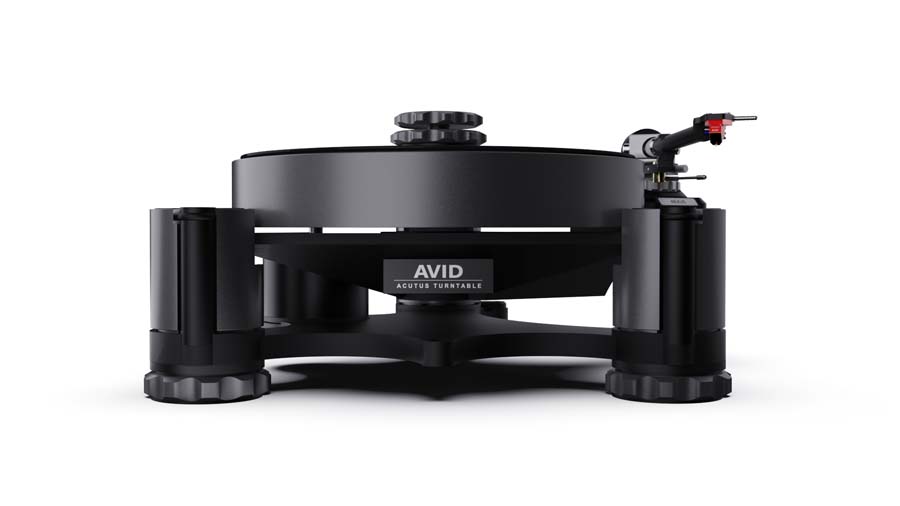
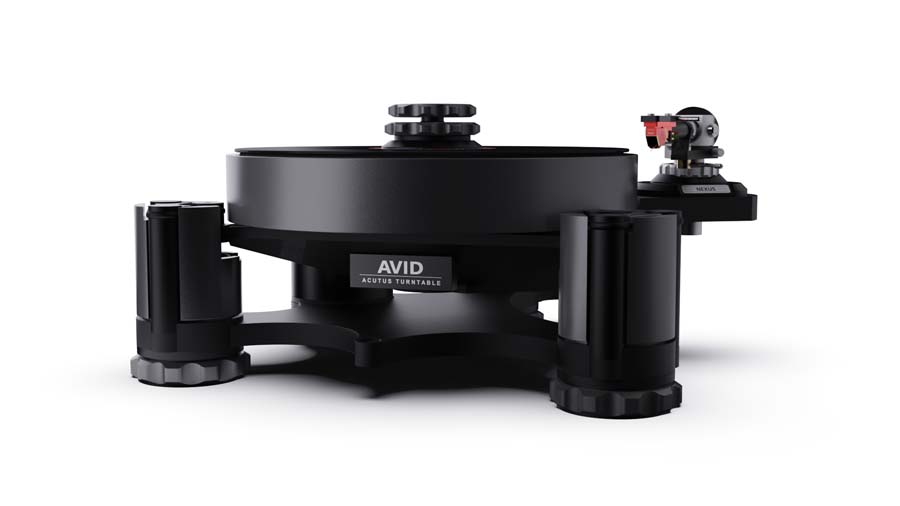
LISTENING TO THE ACUTUS DARK IRON
I must first compliment Conrad on the excellent user support in setting up the turntable. With an excellent user manual and lots of videos you can watch (and even detailing how you repackage it back into the box!), you cannot fail to set up the turntable to work at its very best. Conrad kindly set it all up for me, so I just hoped my listening sessions wouldn’t be a disappointment. Interestingly, at the start, I did a couple of AB tests of music to see how my air-pumping tangential turntable arm on a solid-based turntable system compared with the opposite philosophy of a highly sprung turntable and conventional arm system of the AVID. Wow, there is a lot of difference, even allowing for different cartridges and adjusting load resistance and capacitance! They are so different, and both have their good points. I decided to end my AB comparison quickly; they are like chalk and cheese.
First on the platform of the Dark Iron was Mark Knopfler’s ‘Get Lucky’. This is a very well-engineered and spacious album, and the turntable immediately showed me how controlled it was in translating grooves to music. It made it all just sound so easy, with a very open and precise musicality. This was like driving a 1970s Mini City and then getting into a Rolls Royce Silver Spirit. In the 70s and 80s, all turntables tried to show off their low wow and flutter vital statistics. The specification for the Avid doesn’t even mention it. It doesn’t need to. It is just so low that my musically trained ears couldn’t hear any. That 140Nm motor torque keeps the speed as original as the cutting lathe. And, if my perfect pitch meant I did need to fine-tune the computer-controlled speed regulator (or if I had a strobe-disc at hand), then I can alter the speed by pressing simultaneously both 33 and 45 buttons until they start flashing and then press the 33 to slow the platter or 45 to raise it. You should never need to do this, though. All I found in the initial LPs I played was just a slightly reduced top end and narrower soundstage at the >100-ohms recommended cartridge setting, but this improved once I set my Manley phono-stage at 200-ohm or higher and 210pF loads, creating a tighter and clearer sound-field, with precise vocals and excellent cymbals. Always experiment with the load resistance, as even the cables can add to the conundrum.
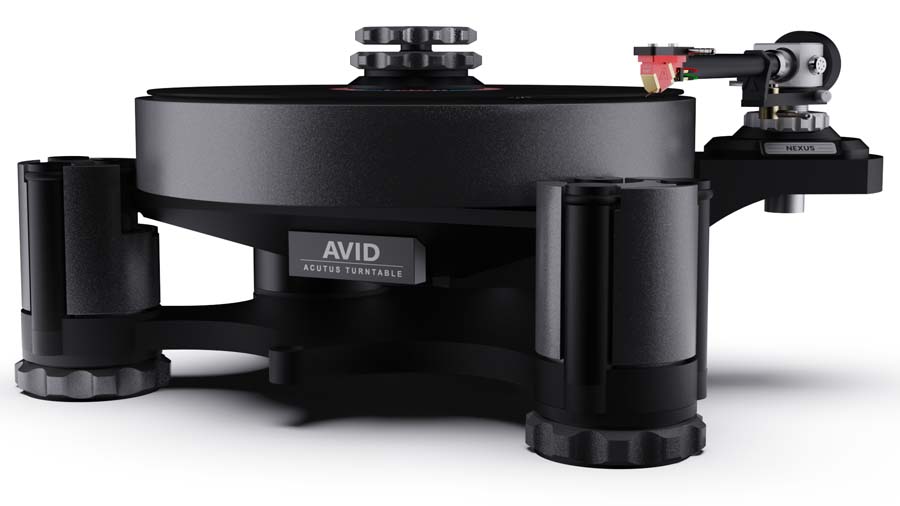
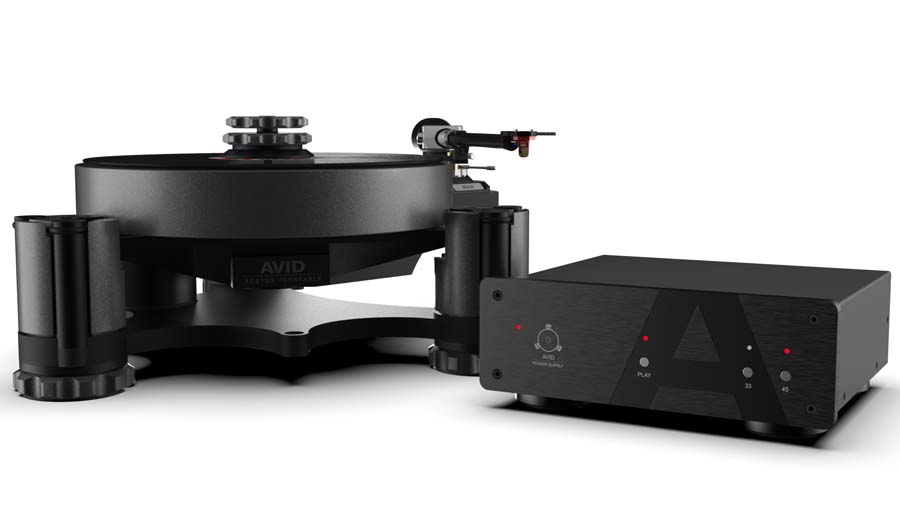
A recent addition to my LP library is the excellent ‘Black Coffee’ album from Lils Mackintosh, released this year. Engineered by one of my favourite studio managers, this DMM LP was recorded way back in 1994. Lils never got to see this album as she died in 2023, though she did hear the master tape after the 3-day recording session. Her vocal style is very much along the lines of Billie Holiday, Ella Fitzgerald, and Sarah Vaughan. Lots of energy or no energy at all, depending on the music, and the turntable gives a very organic performance that just gets your attention. Side two starts with “Dear Dream”, and the motor’s silence was immediately apparent in the slip-road onto that first track. This is a very quiet turntable, and the amount of detail excavated by that Boron cartridge was exquisite. The music just played with such control and passion on this track, which she wrote after a bout of depression. Indeed, she was either a very engaging, forward lady or else very timid, and her character does come across in the music, with the help of a swinging guitar, harmonica, bass, vibraphone, saxophone, piano and flugelhorn. Indeed, in all the music I played, I felt an amazing sense of interaction and co-operation between the turntable, arm and cartridge that led to a complete harmony in the performances. Soundstage, frequency response, musicality and bandwidth were all as good as I thought vinyl could get.
With all those different instruments positioned so precisely, I then put on ‘Medieval and Renaissance Music Introduced by David Munrow’, an LP originally from Oryx and later EMI that explained and performed various early instruments from the 12th century onwards. Brilliantly engineered, this album not only captures the music so well, but also has the shy spoken voice of David to explain the instruments. I always find spoken word difficult to sound good on vinyl, and any decent loudspeaker manufacturer will use speech to fine-tune their creations, as well as, of course, listening to music. With Spanish bagpipes, shawms, recorders, bells, flute, tabor, crumhorn, gemshorn, psaltery and many other weird sounds from history, the turntable and arm had no problems in tracking any of the instruments, and with the silent noise-floor of the recording, it made it all very clear and enjoyable. The square and pulse-waves from the reeds and sinewaves from the flute were equally precise and indicated the perfect alignment of the Dark Iron as well as any Ortofon set-up disc. Whilst spoken voice is good to explore, so is the piano. As a student pianist who often bought solo piano and piano concerto LPs as a child, I often found them hard to sound perfectly authentic on my Trio, Pioneer or Thorens decks. Not only is the piano as a source easy to indicate any wow and flutter, but a turntable can often make a Steinway grand sound more like a school Danemann upright. Testing the piano on a mono LP would be more like sacrilege, so come in ‘The Other Side’ from The Dudley Moore Trio. I first heard this mono jazz album as a young child when the family HiFi was a massive Pye radio and gramophone cabinet. Surprisingly, the AVID coped brilliantly; no movement within the soundfield, and the complete mastery of the Dark Iron almost made the music come to life, and it being mono just didn’t seem to matter anymore. The piano, double-bass and drum ensemble played with an amazing sense of control and ease. The comedic personality of actor and musician Dudley filtered through the 9 pieces with power and ease. Even his explorations at the very top octave of the piano in “Baubles, Bangles and Beads” sounded like he was telling jokes, though the only humour for me was the very out-of-tune top ‘A’!
Turning to Respighi’s ‘Pini di Roma’ gave me another chance to check out timing, tracking, and musical verve. This twentieth-century music has just about everything in it, including a taped recording of a nightingale. Respighi might have written 8 operas, 3 ballets and several concertos, but it is this work that he is best known for, and many scholars will spend hours arguing as to which is the “best” recording. This one, with The Cleveland Orchestra, is great for testing out the turntable and arm. There is so much atmosphere in this work set in a Pine Forest that you can almost smell the wood. Indeed, the composer once wrote, “I use nature as a point of departure, so that I might recall memories and visions”. This impressionist work certainly gets your mind cells flowing. Again, the timing from the AVID is impeccable, and the third movement, “The Pine Trees near Catacomb”, has brilliantly clear piano and clarinet solos mingled in with the colourful orchestration. Along with that taped nightingale appearing towards the end, this is real Disney soundtrack music! My only observation was that it all sounded just too easy, too tidy. I wanted a little bit more excitement.
Side H of Pink Floyd’s Echoes album begins with “Wish You Were Here”, a great track to determine if your wiring is the right way round with its musique concrete start on the far right and then the vocal breath and acoustic guitar entry dead-centre. With the vocals, drums, piano and orchestration being added to the mix, you get a great sense of atmosphere, texture and timbre, though I would perhaps have heard slightly less congestion. The word “Acutus”, by the way, means “sharp” and certainly explains the detail you can get from the turntables. The punchy drum-beat from “The Division Bell” was very controlled and substantial, and the track, with all its great moments of tension build-up and then the release into moments of quietness, is brilliantly portrayed from the turntable.
QUIBBLES
It is always hard to find issues with AVID gear, but if I had a quibble, it would be the stylus being so vulnerable to being knocked by kids or cats, or your housemaid. It sticks out so far in front of the assembly. I wish there were an opaque plastic protection over the top, though that would add weight to the cartridge and probably affect the sound. Some may, of course, find the price a hindrance, and whilst Conrad’s mother might have arrived from Spain and his father from Australia, Conrad is English born and bred, and very proud of it, so it had to be made in England, which will add to the price. This is British engineering at its best.
CONCLUSION
I am never disappointed when I get to review a product from AVID. I cannot ever identify just one area that works so well, as it is the sum of all the parts that together make the product that so ekes musicality and confidence; a synergy. Forget reading the specification, just take a listen. Its name might suggest power and fear, but this turntable is as tame and friendly as your best friend, and if you buy one, it certainly will be.
AT A GLANCE
Build Quality:
AVID products are always made to the highest order, and this is no exception
Sound Quality:
An honest and musical performance is had from all types of music
Value For Money:
It ain’t cheap, but the standard of craftsmanship and musical prowess make this a bargain at whatever price Conrad might stick on it
We Loved:
Detail and accuracy in all music
Exceptionally good noise floor from a turntable
Vivid musicality from the cartridge
Makes vinyl sound as good as it can get
Excellent packaging and set-up instructions
We Didn’t Love So Much:
Wish I could afford one
Elevator Pitch Review: Conrad, the owner of AVID HIFI, never ceases to amaze me with his products, whether amplifier, speaker, or vinyl. He just wouldn’t put his name on a product unless he felt it was good, and it will always be analogue! The name Dark Iron might inspire thoughts of power and anger, but this turntable was a walkover. After only a few minutes, it was my friend, and I just wanted to let it keep playing to me. At £22k for turntable, arm and cartridge, it is still cheap for AVID prices, but would it be friendly enough for me to buy?
Price:
£10,000 Basic Acutus Dark Iron
£2,500 Upgraded resin mat
(£500 Upgraded clamp is also available)
£4,950 Nexus arm
£4,500 Boron Cartridge
Janine Elliot
Audio System used:
Manley Steelhead (phono-stage); MFA Baby Reference and Synthesis Roma 98DC KT88 mono-block (pre/power amplifiers); Wilson Benesch Arc and Torus infrasonic generator, and Graham Audio LS5/9, Townshend Supertweeter (loudspeakers); Tellurium Q and Townshend interconnects, Russ Andrews/Ecosse mains cables, Coppice Audio stand and Townshend rack.
SUPPLIED SPECIFICATION
DRIVE: TWIN BELT DRIVE
SPEEDS: 33.3 & 45.0 RPM (ADJUSTABLE)
PLATTER MASS: ALUMINIUM 10KG
BEARING: INVERTED STAINLESS STEEL
THRUST POINT: TUNGSTEN CARBIDE/SAPPHIRE
SUSPENSION: 3 POINT SPRING Vertical 2.5Hz, Lateral 4.5Hz
TONEARM FITTING: SME TEMPLATE
ADAPTERS AVAILABLE: YES: SINGLE OR TWIN TONEARMS
MOTOR: 24V 140mNm AC Synchronous
POWER SUPPLY: DSP VARI-SPEED CONTROL UNIT
VOLTAGE INPUT: 100-240VAC 50/60Hz 20 Watts Max.
DIMENSIONS:
Turntable (overall) 460 x 400 x 210mm (WxDxH)
Turntable (footprint) 410 x 360mm (WxD)
P.S.U. 250 x 215 x 95mm (WxDxH)
NET WEIGHT:
19.0Kg (42lb) turntable only
3.5Kg (8lb) psu only
























































